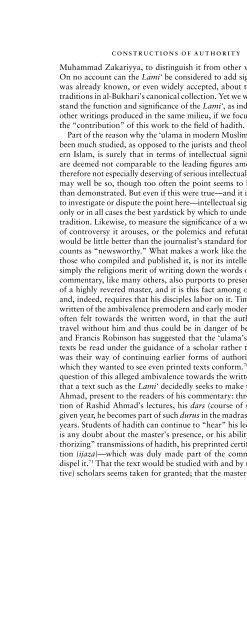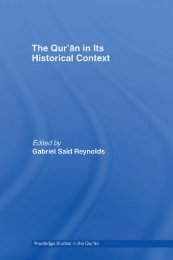Download (1 MB) - Islam and Christian-Muslim Relations: Articles ...
Download (1 MB) - Islam and Christian-Muslim Relations: Articles ...
Download (1 MB) - Islam and Christian-Muslim Relations: Articles ...
Create successful ePaper yourself
Turn your PDF publications into a flip-book with our unique Google optimized e-Paper software.
CONSTRUCTIONS OF AUTHORITY 51Muhammad Zakariyya, to distinguish it from other works of its genre.On no account can the Lami‘ be considered to add significantlyto whatwas alreadyknown, or even widelyaccepted, about the meaning of thetraditions in al-Bukhari’s canonical collection. Yet we would fail to underst<strong>and</strong>the function <strong>and</strong> significance of the Lami‘, as indeed those of manyother writings produced in the same milieu, if we focused exclusivelyonthe “contribution” of this work to the field of hadith.Part of the reason whythe ‘ulama in modern <strong>Muslim</strong> societies have notbeen much studied, as opposed to the jurists <strong>and</strong> theologians of premodern<strong>Islam</strong>, is surelythat in terms of intellectual significance the formerare deemed not comparable to the leading figures among the latter, <strong>and</strong>therefore not especiallydeserving of serious intellectual engagement. Thatmaywell be so, though too often the point seems to be assumed ratherthan demonstrated. But even if this were true—<strong>and</strong> it is not myintentionto investigate or dispute the point here—intellectual significance is not theonlyor in all cases the best yardstick bywhich to underst<strong>and</strong> a culture ortradition. Likewise, to measure the significance of a work bythe amountof controversyit arouses, or the polemics <strong>and</strong> refutations it generates 68would be little better than the journalist’s st<strong>and</strong>ard for determining whatcounts as “newsworthy.” What makes a work like the Lami‘ unique, forthose who compiled <strong>and</strong> published it, is not its intellectual acumen, norsimplythe religions merit of writing down the words of the pious. 69 Thiscommentary, like many others, also purports to preserve the “presence”of a highlyrevered master, <strong>and</strong> it is this fact among others that justifies<strong>and</strong>, indeed, requires that his disciples labor on it. TimothyMitchell haswritten of the ambivalence premodern <strong>and</strong> earlymodern <strong>Muslim</strong> scholarsoften felt towards the written word, in that the author’s words couldtravel without him <strong>and</strong> thus could be in danger of being misconstrued;<strong>and</strong> Francis Robinson has suggested that the ‘ulama’s insistence that alltexts be read under the guidance of a scholar rather than on one’s ownwas their wayof continuing earlier forms of authoritative learning, towhich theywanted to see even printed texts conform. 70 Leaving aside thequestion of this alleged ambivalence towards the written word, it is clearthat a text such as the Lami‘ decidedlyseeks to make the master, RashidAhmad, present to the readers of his commentary: through the preservationof Rashid Ahmad’s lectures, his dars (course of study), during onegiven year, he becomes part of such durus in the madrasa in all subsequentyears. Students of hadith can continue to “hear” his lectures, <strong>and</strong> if thereis anydoubt about the master’s presence, or his abilityto continue “authorizing”transmissions of hadith, his preprinted certificate of authorization(ijaza)—which was dulymade part of the commentary—ought todispel it. 71 That the text would be studied with <strong>and</strong> by(actual or prospective)scholars seems taken for granted; that the master is once again part



